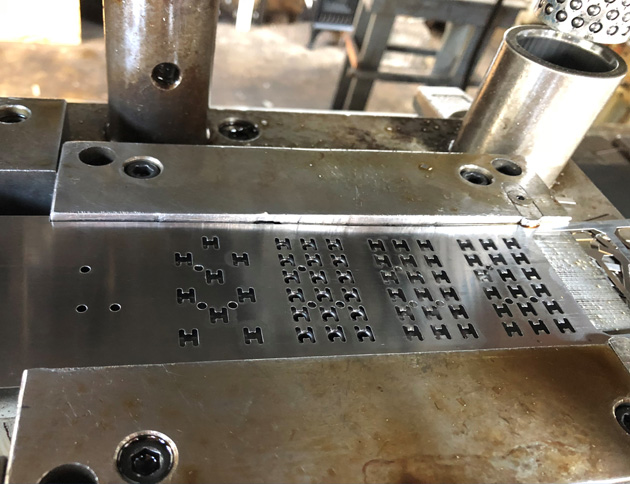Advanced Techniques in Metal Stamping for Precision Production
In the world of precision production, the advancement of metal marking methods has been a pivotal pressure in achieving unrivaled levels of precision and efficiency. As sectors continuously demand finer resistances and elaborate layouts in their metal parts, the quest for innovative methods in steel stamping has actually heightened. From the application of advanced multi-stage marking processes to the combination of cutting-edge automation innovations, the landscape of metal stamping is undertaking a profound improvement. In this vibrant arena, the merging of innovation and precision is improving the opportunities of what can be accomplished in steel manufacture.
Advanced Multi-Stage Stamping Processes
Going over the details of innovative multi-stage marking processes reveals the sophisticated methods utilized in modern manufacturing methods. Metal Stamping. Multi-stage marking is an intricate procedure that entails numerous actions to change a level sheet of steel right into a last stamped item. Using dynamic passes away, where various procedures are executed at each phase of the marking procedure, permits high accuracy and performance in the production of complex steel components
Throughout the preliminary stages of multi-stage stamping, the flat metal sheet is fed into the stamping press, where a series of dies are used to cut and form the product. Succeeding phases involve extra developing, flexing, and punching procedures to more refine the part. Each phase is very carefully created to build upon the previous one, resulting in the production of complex geometries with tight resistances.
Advanced multi-stage marking processes require a high level of proficiency and accuracy to guarantee the high quality and consistency of the stamped parts. By making use of innovative equipment and tooling, manufacturers can produce a vast array of steel elements with effectiveness and precision.
Precision Tooling Innovations
Precision tooling developments have changed the metal marking market, boosting efficiency and high quality in making processes. CNC systems enable for detailed designs to be equated straight right into tooling, ensuring accuracy and repeatability in the marking process.
In addition, the integration of sensors and real-time monitoring capabilities in precision tooling has allowed makers to identify and resolve concerns promptly, minimizing downtime and reducing scrap rates. By incorporating smart technology right into tooling, drivers can maximize criteria such as stress, rate, and positioning throughout the marking procedure, leading to enhanced product quality and increased productivity.

Automation in Steel Stamping
The evolution of precision tooling developments in the metal stamping industry has actually led the means for considerable improvements in automation, transforming the manufacturing landscape in the direction of boosted effectiveness and efficiency. Metal Stamping. Automation in metal marking includes using sophisticated equipment and robotics to do different jobs commonly performed by human operators. This change towards automation provides countless advantages, including boosted precision, faster manufacturing cycles, and decreased labor costs
One key facet of automation in steel stamping is the implementation of computer mathematical control (CNC) systems, which enable specific control over the stamping procedure. CNC modern technology enables the creation of complicated and intricate steel parts with regular quality. In addition, automated systems can be configured to run continually, causing greater outcome prices and shorter preparations.
Furthermore, automation boosts workplace safety and security by reducing hands-on handling of hefty materials and lessening the risk of mishaps (Metal Stamping). As making industries proceed to welcome automation, the future of metal stamping holds wonderful guarantee for also better efficiency and advancement
High-Speed Stamping Techniques

Among the key benefits of high-speed marking strategies is the capacity to generate a huge quantity of components in a much shorter quantity of time contrasted to standard marking techniques. This boosted efficiency not only read more enables producers to satisfy tight production deadlines but also enables price financial savings via economic situations of range. Furthermore, high-speed stamping can help reduce material waste by optimizing the product usage throughout the marking procedure.
Moreover, high-speed stamping techniques frequently include ingenious functions such as quick die adjustment systems and real-time surveillance abilities, even more enhancing the total effectiveness and try these out versatility of the metal marking process. As technology proceeds to development, high-speed stamping is anticipated to play a critical duty in driving the future of precision production.
Quality Assurance in Stamping Procedures
Efficient quality assurance actions are vital for guaranteeing the integrity and consistency of steel stamping operations. Quality assurance in stamping procedures involves a collection of systematic procedures targeted at identifying and stopping defects in the made components. One critical aspect of top quality control in metal marking is making use of sophisticated inspection methods such as optical inspection systems and coordinate determining equipments (CMMs) to confirm the measurements and tolerances of stamped parts.
In addition, quality assurance procedures in marking operations commonly consist of the implementation of analytical procedure control (copyright) methods to keep an eye on the manufacturing process in real-time and guarantee that it continues to be within appropriate limits. By examining information and recognizing trends, makers can proactively resolve any discrepancies from the preferred top quality standards.
Additionally, high quality control in steel marking procedures additionally involves comprehensive material testing to make sure that the raw products made use of fulfill the required specifications for the stamping process. This might consist of performing product solidity examinations, tensile toughness examinations, and dimensional examinations to guarantee the quality and integrity of the stamped components. Overall, applying robust quality assurance steps is important for attaining high-grade stamped components continually.
Verdict
To conclude, progressed methods in metal stamping play an important role in precision production procedures. With multi-stage stamping processes, innovative tooling solutions, automation, high-speed strategies, and strenuous high quality control steps, producers can achieve greater degrees of accuracy and efficiency in their procedures. These improvements in metal stamping modern technology have actually enabled companies to generate complicated get rid of limited tolerances, ultimately bring about enhanced product top quality and client complete satisfaction in the manufacturing sector.
Comments on “Comprehensive Guide to Metal Stamping: Methods, Applications, and Advantages”